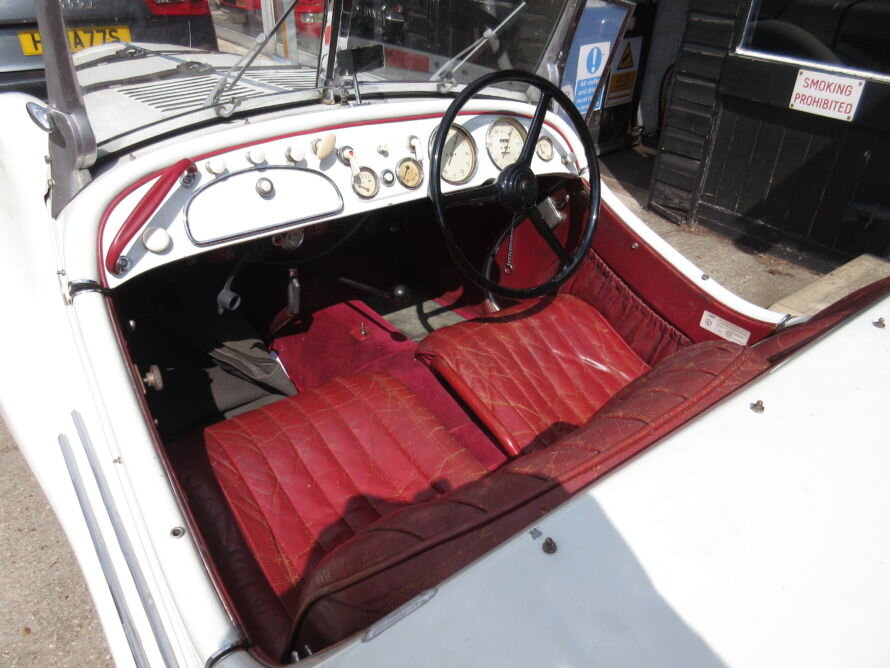The BMW 328 Frazer Nash by Howard Watts
We are privileged to have been entrusted by the family owners of this famous BMW 328 to carry out running repairs in our workshop. Sir Stirling Moss's father Alfred Moss owned the car from 1946-50 during which time it was raced by his son at the start of his racing career, taking part in the 1947 Poole Speed Trials, Harrow Car Club Trial winning the Cullen Cup, winning the NW London MC Inter-club trial and class winner of the JCC Eastbourne Rally.
BMW Fraser Nash badge
The British car company, Frazer Nash, was famous during the 1930s for its own chain driven sports cars. Meanwhile in Germany the BMW 328, with its 2 litre, six cylinder, highly efficient engine, was almost unbeatable, winning the 1940 Mille Miglia, a class victory in the Le Mans 24 hours and the Alpine Rally, and winning at the Nurburgring in 1936. In order not to be outshone, Frazer-Nash acquired the British rights to the 328 in 1934 and marketed the car in right hand drive form. The Frazer-Nash BMW was a great success for the Company and beame a very poular choice for both amateur and professional drivers at venues like Brooklands and elsewhere.
The history of the Frazer Nash company dates back to the early 1920s and was founded by Archibald Frazer-Nash along with partner Ron Godfrey. On its financial collapse in 1927, a new company AFN Limited was incorporated and in 1929 control of AFN passed to Harold John Aldington. Until the Second World War, AFN continued to produce a small number of sports cars badged Frazer-Nash incorporating a unique multi-chain transmission. It continued after the war making another 85 sports cars before ending manufacture in 1957. The post-war cars had conventional transmissions. AFN Ltd became importers and assemblers of BMW cars in 1934 and sold them as Frazer Nash BMW. They were the official British BMW importer until the outbreak of war in 1939.
Seats once previously occupied by Sir Stirling Moss
The car has a very light coupe and convertible body fabricated in aluminium. The coupe version originates from the design house, Touring, at that time situated in Milan. The body design was credited to Peter Szymanowski, who became BMW chief of design after World War II (although technically the car was designed by Fritz Fiedler). Touring held the patent for the especially light grid tubular frame directly under the aluminium shell. The engine, modern for its time, features an aluminium head and, in spite of the under head camshaft with V shaped over hanging valves, the car exhibits a good racing performance. The rack and pinion steering and hydraulic brake system were also fairly advanced. The interior is sumptiously furnished in red leather upholstery, door cards and pockets with a deep pile red carpet.
The car inadvertently influenced the creation of Bristol Cars. After the second world war one of the Mille Miglia 328s (disguised as a Fraser Nash in order to bring is safely back to English soils) and BMW’s technical plans for the car were taken from the bombed BMW factory by English representatives from the Bristol Aeroplane Company and Frazer Nash companies (then lead by John Aldington). Fiedler, the BMW engineer, was persuaded to come, too. Bristol Cars was set up to build complete cars, called Bristols, and would also supply engines to Frazer Nash for all their post-war cars. The first Bristol car, the 400, was heavily based on the BMW plans.
Original steering wheel and instrumentation
The 328 was introduced at the Eifelrennen race at the Nurburgring in 1936, where Ernst Henne drove it to win the 2.0-litre class. The 328 had more than 100 class wins in 1937, including the RAC Tourist Trophy, the Osterreichishe Alpenfart and the La Turbie hillclimb. In 1938, the 328 won its class at the RAC Tourist Trophy, the Alpine Rally and the Mille Miglia. The 328 won the RAC Rally in 1939 and came fifth overall and first in class in the 1939 24 Hours of Le Mans. Frank Pratt won the 1948 Australian Grand Prix driving a pre war 328
Of course we just had to take it for a test drive to test the rebuilt clutch mechanism
This car has been in single family ownership since 1983 and was brought back from Australia in 1987. It remains in their UK collection. In their ownership it has won numerous competitions and is still actively raced today. It was reunited with Sir Stirling Moss at the 2012 Prescott Hill Climb and subsequently driven by him at the 2012 Goodwood Revival. Between 1989 and 2003 it was raced in the Pomeroy Trophy 8 times, coming first on no less than 4 occasions and winning the Densham Trophy. The car features in Stirling Moss’s book “My cars, my career” and is car No. 89 in the famous profiles by Dennis Jenkinson or “Jenks” as he is more commonly known to Motorsport readers. We were excited to be asked to carry out various repairs to put the car back into road and race worthy condition. These included, amongst other things, re-fabricating the clutch pedal (which had snapped) and re-commissioning and re-installing the wiper mechanism.
Our experienced technicians can undertake repairs and re-commissioning work to all types of historic and classic cars. Please do not hesitate to call if we can help to solve any automotive problem you may have.







